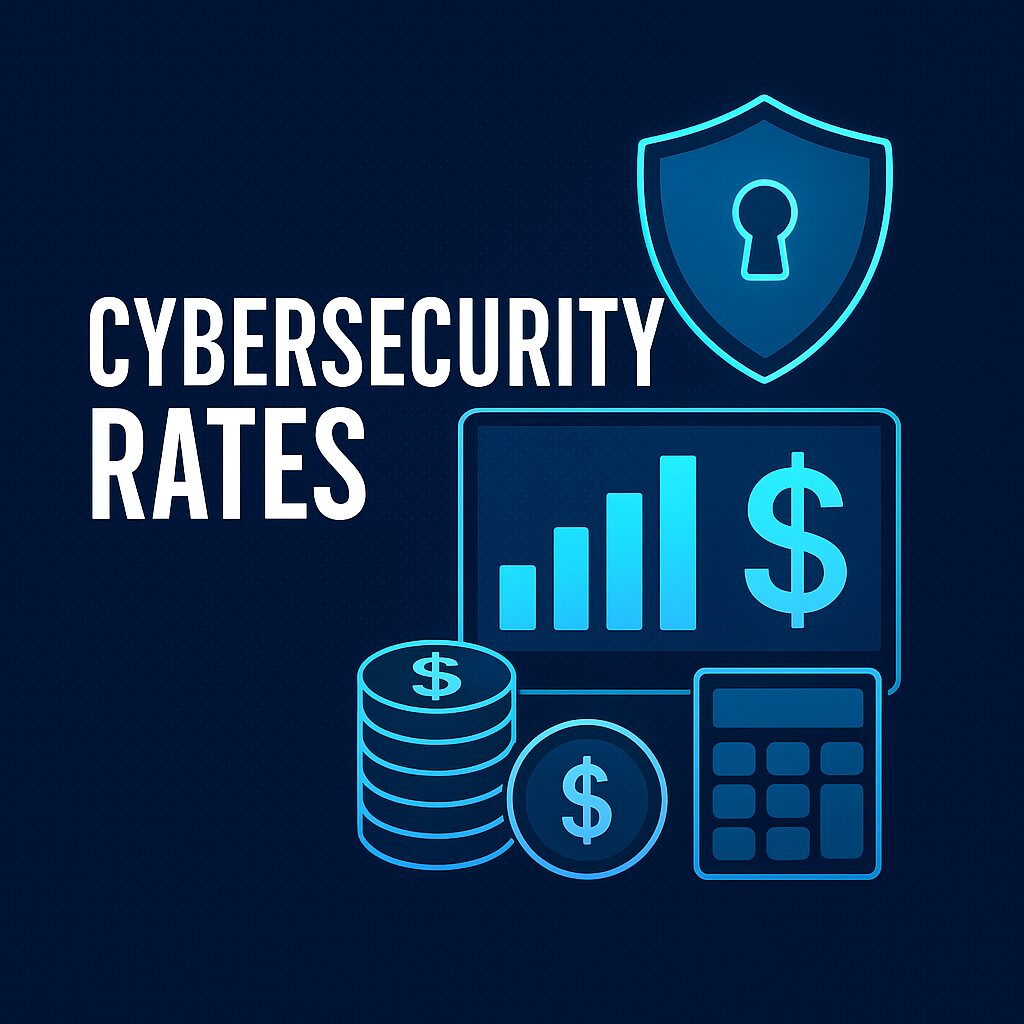How to Evaluate Pricing and Choose Wisely
Cybersecurity services can range from a few hundred dollars for a one-time scan to thousands per month for ongoing monitoring and compliance. With such a wide spectrum of rates, how do you know if you’re paying a fair price?
In this post, we’ll break down the different types of cybersecurity services, typical pricing models, and the factors that drive costs up or down. We’ll also explore how to evaluate whether a firm’s rates align with the value they deliver. By the end, you’ll know exactly what to look for — and what to avoid — when shopping for a cybersecurity partner.
Why Do Cybersecurity Rates Vary So Widely?
Unlike a commodity product, cybersecurity isn’t “one-size-fits-all.” Rates differ because of:
- Scope of Work – A basic vulnerability scan is far cheaper than a comprehensive risk assessment and remediation plan.
- Specialization – Advanced services like penetration testing or incident response often command premium pricing.
- Industry Needs – Regulated industries like healthcare or finance require extra compliance layers, which increase costs.
- Engagement Type – A one-off project costs differently from an ongoing managed security service.
Common Cybersecurity Pricing Models

When evaluating firms, you’ll encounter several pricing structures. Understanding them helps you compare apples to apples.
- Hourly Rates
- Typically range from $100–$500/hour depending on expertise.
- Best for short-term consultations or incident response.
- Watch out: hourly billing can balloon if the scope isn’t clearly defined.
- Project-Based Pricing
- Flat fee for defined work (e.g., $10,000 for a penetration test).
- Transparent and predictable, but may exclude “out-of-scope” issues.
- Monthly Retainer / Managed Services
- Ongoing monitoring, threat detection, and compliance support.
- Pricing ranges from $2,000 to $20,000+/month depending on company size and complexity.
- Provides long-term coverage but requires a steady budget commitment.
- Per-User or Per-Device Pricing
- Common for endpoint protection or SaaS security solutions.
- Ranges from $5–$50 per user/device per month.
- Scales easily but may get expensive in large organizations.
How to Evaluate Cybersecurity Rates
1. Define Your Goals Clearly
Ask yourself:
- Do we need basic compliance help or advanced threat monitoring?
- Is this a one-time project, or do we want a long-term partnership?
- What’s our risk tolerance and budget flexibility?
Clear goals prevent overpaying for unnecessary services.
2. Assess the Firm’s Expertise
Rates should reflect value. A consultant with CISSP, OSCP, or CISM certifications plus 10+ years in your industry may charge more — but can save you costly mistakes. Compare experience against rates rather than just chasing the lowest bid.
3. Look Beyond the Sticker Price
Ask:
- What deliverables are included?
- How detailed will the reports be?
- Do they provide implementation support or just recommendations?
- Is employee training included?
The cheapest proposal may actually cost more in the long run if it leaves gaps.
4. Request Transparent Proposals
A good cybersecurity firm will break down costs clearly:
- Initial assessment fees
- Testing or scanning tools used
- Ongoing monitoring costs
- Optional add-ons (like incident response)
Transparency prevents “surprise” charges.
What Factors Influence Cybersecurity Pricing?
- Company Size and Complexity
- Small businesses may need basic coverage.
- Enterprises with hybrid cloud, global offices, and legacy systems will pay more.
- Compliance Requirements
- HIPAA, PCI-DSS, GDPR, or SOC 2 compliance adds cost due to documentation and auditing.
- Level of Risk
- Firms in high-risk sectors (finance, healthcare, defense) often face higher rates because of targeted attacks.
- Geographic Location
- U.S. and Western European firms generally charge more than those in Asia or Eastern Europe.
- Be cautious: cheaper rates offshore may come with time-zone or compliance challenges.
- Service Level Agreements (SLAs)
- Faster response times and 24/7 coverage increase pricing but may be critical for mission-critical operations.
Comparing Firms: What to Ask
When reviewing proposals, ask:
- What’s included in your base rate?
- What additional costs should we expect?
- Can you share examples of ROI from past clients?
- Do you price differently for ongoing vs. one-time services?
- How do you handle scope creep or unexpected incidents?
These questions expose hidden costs and reveal how the firm values transparency.
Red Flags in Cybersecurity Pricing
Watch for these warning signs:
- Rates that are “too good to be true.” They may lack experience or outsource to cut costs.
- Vague deliverables. If they can’t explain what you get for your money, move on.
- One-size-fits-all pricing. Every company’s environment is unique; pricing should reflect that.
- Hidden fees. Clarify up front what happens if the project scope changes.
Balancing Cost vs. Value
Cybersecurity is an investment in risk reduction. Consider:
- Average cost of a data breach: $4.45 million (IBM, 2023).
- Reputational damage: customer trust lost, legal action, and regulatory fines.
- Downtime costs: even a few hours offline can hurt revenue.
Spending more on the right firm may save millions later. The question isn’t “How much does cybersecurity cost?” but “How much would a breach cost us without it?”
Example Pricing Scenarios
- Small Business Penetration Test: $7,500 for a one-time assessment.
- Mid-Sized E-commerce Firm: $5,000/month for managed detection & compliance support.
- Enterprise Financial Institution: $250,000+ annually for continuous monitoring, incident response, and compliance audits.
These are ballpark numbers, but they illustrate how size and scope shape pricing.
Other Considerations
Cybersecurity rates vary widely because no two businesses have the same risks, compliance requirements, or infrastructure. When evaluating firms:
- Define your goals clearly (compliance, monitoring, testing).
- Compare expertise, not just rates.
- Ask for transparent proposals with clear deliverables.
- Weigh the cost against the value of risk reduction.
The cheapest option isn’t always the most cost-effective. The right cybersecurity partner provides protection, compliance, and peace of mind — making their rates not just a cost, but an investment in your organization’s future resilience.
Frequently Asked Questions About Cybersecurity Rates
1. What is the average hourly rate for a cybersecurity consultant?
Hourly rates typically range from $100 to $500, depending on expertise, certifications, and location. Senior consultants with specialized skills (e.g., penetration testing or incident response) may charge higher rates.
2. How much does a penetration test usually cost?
A one-time penetration test generally ranges from $5,000 to $20,000, depending on company size, network complexity, and scope. Larger enterprises with multiple applications and environments can expect higher costs.
3. What should small businesses budget for cybersecurity?
Small businesses often spend between $2,000 and $10,000 annually for basic services like vulnerability scans, endpoint protection, and compliance checks. More advanced monitoring may cost $1,500–$5,000 per month.
4. Why are managed cybersecurity services so expensive?
Managed security services (MSSPs) often cost more because they include 24/7 monitoring, incident response, compliance support, and advanced tools. While monthly fees range from $2,000 to $20,000+, they often replace the need for a full in-house security team.
5. Are cheaper offshore cybersecurity firms a good option?
Offshore firms can provide cost savings, but may introduce compliance challenges, time-zone delays, and communication gaps. For regulated industries (finance, healthcare), local expertise is often worth the premium.
6. How do I know if I’m being overcharged?
Compare multiple proposals, check what’s included in the rate, and ask for case studies that demonstrate ROI. If a firm can’t clearly explain its pricing structure or deliverables, that’s a red flag.
7. What factors most influence cybersecurity pricing?
The biggest factors are:
- Company size and network complexity
- Compliance requirements (HIPAA, PCI-DSS, GDPR, etc.)
- Service type (one-time project vs. ongoing monitoring)
- Risk profile (industry, data sensitivity)
- Service-level agreements (SLA) for response times
Final Takeaway
Cybersecurity rates can look intimidating, but the real cost comes from underestimating the impact of a breach. By asking the right questions, comparing proposals transparently, and focusing on value over price, you can find a cybersecurity partner that fits both your budget and your long-term security goals.

